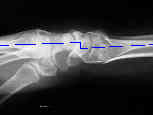- Discussion: (see: dynamic instability);
- type of non dissociative carpal instability;
- capitolunate joint has high potential for instability, since it is mainly stabilized only by radiocapitate ligament (and captiotriquetral ligament, to a lesser degree); (see wrist ligaments);
- may result from malreduced radial styloid frx, or any condition which shortens or reduces tension in the ligament;
- often results from severe dorsiflexion injury;
- ligamentous injury:
- see: ligaments of the wrist
- treatment involves stabilization of dorsal triquetro-hamate joint;
- note that there is anecdotal evidence that this treatment method will fail in patients w/ distal radial malunion;
- diff dx:
- distal radial malunion
- distal radial malunion w/ excessive dorsal tilt often leads to ulnar midcarpal instability;
- in the report by Taleisnik and Watson 1984, the average amount of dorsal tilt which caused significant symptoms was 23 deg, however, in one case a patient had symptoms w/ 8 deg of volar tilt;
- the most logical procedure is opening wedge osteotomy, which should normalize the carpal relationships;
- Kienbock's, scapholunate diastatsis, capitate frx, lunotriquetral diastasis;
- no VISI or DISI deformity should be present;
- Clinical Findings:
- patients may note wrist clicking and pain while lifting heavy objects;
- grasping in supination may provoke symptoms;
- symptoms may include tenderness over lunocapitate and triquetrohamate joints;
- the later is thought to be the more affected joint;
- painful audible snap often results from active ulnar deviation w/ forearm pronation;
- the flexion subluxation of the proximal carpal row causes the reduction clunk (proximal row extension) as the wrist moves into ulnar deviation;
- some loss of palmar flexion is usually present;
- grip strength can be decreased by as much as 50%;
- ref: Quantitative assessment of the midcarpal shift test.
- Radiographs:
- PA View
- Radial Inclination
- Radial Length
- Lateral View
- Fat Pads (in the case of occult injury)
- Palmar Slope
- look for dorsal tilt of the lunate (DISI deformity);
- excessive dorsal tilt is associated w/ ulnar mid carpal instability;
- Ulnar Deviation Lateral View:

- normally ulnar deviation will cause the lunate to dorsiflex and shift volarly, and the radio-luno-capitate alignment resembles a DISI pattern
- volar shift of the lunate helps maintain the normal co-linear relationship of the radius and the capitate;
- w/ mid carpal ulnar instability, the lunate will dorsiflex, but will not have normal palmar translation;
- hence, the longitudinal axis of the capitate lies above the axis of the radius;
- this "zig zag" deformity would be expected to cause symptoms following distal radial fractures even if the loss of volar tilt was minimal;
- Stress Radiographs:
- dorsal capitate displacement apprehension test;
- surgeon uses flouroscopy to evaluate stressed lateral radiograph;
- grasp the distal radius so that it is well anchored;
- the surgeon then translates the capitate dorsally (and volarly) with the other hand;
- look for marked dorsal (or volar) shift of the capitate over the lunate
Midcarpal instability caused by malunited fractures of the distal radius.
Carpal Instability Non-Dissociative.
Ulnar midcarpal instability - clinical and laboratory analysis.
Post traumatic carpal instability.
Chronic capitolunate instability
Central Carpal Instability - Capitate Lunate Instability Pattern. Diagnosis by Dynamic Displacement. Lousi DS, et al. Orthopedics. 1984;7(11):1693-1696.
Palmar midcarpal instability: the results of treatment with 4-corner arthrodesis.

